Motor INFINITI M35 2006 Factory Service Manual
[x] Cancel search | Manufacturer: INFINITI, Model Year: 2006, Model line: M35, Model: INFINITI M35 2006Pages: 5621, PDF Size: 65.56 MB
Page 16 of 5621
![INFINITI M35 2006 Factory Service Manual DESCRIPTION
ACS-7
[ICC]
C
D
E
F
G
H
I
J
L
MA
B
ACS
Revision: 2006 January2006 M35/M45
Components DescriptionNKS004CH
CAN CommunicationNKS004CI
CAN (Controller Area Network) is a serial communication l INFINITI M35 2006 Factory Service Manual DESCRIPTION
ACS-7
[ICC]
C
D
E
F
G
H
I
J
L
MA
B
ACS
Revision: 2006 January2006 M35/M45
Components DescriptionNKS004CH
CAN CommunicationNKS004CI
CAN (Controller Area Network) is a serial communication l](/img/42/57023/w960_57023-15.png)
DESCRIPTION
ACS-7
[ICC]
C
D
E
F
G
H
I
J
L
MA
B
ACS
Revision: 2006 January2006 M35/M45
Components DescriptionNKS004CH
CAN CommunicationNKS004CI
CAN (Controller Area Network) is a serial communication line for real time application. It is an on-vehicle mul-
tiplex communication line with high data communication speed and excellent error detection ability. Many elec-
tric control units are equipped onto a vehicle, and each control unit shares information and links with other
control units during operation (not independent). In CAN communication, control units are connected with 2
communication lines (CAN H line, CAN L line) allowing a high rate of information transmission with less wiring.
Each control unit transmits/receives data but selectively reads required data only.
CAN COMMUNICATION UNIT
Refer to LAN-34, "CAN Communication Unit" .
ComponentVehicle-to-
vehicle
distance
control modeConventional
(fixed speed)
cruise
control modeBrake assist
(with pre-
view func-
tion)Description
ICC sensor integrated unit
Controls vehicle distance by operating electric throttle
control actuator based on that sensor signals and
CAN communication data.
Controls vehicle distance by transmitting deceleration
degree commandment value signal to ABS actuator
and electric unit (control unit) when deceleration with
brake is needed.
Irradiates laser beam, and receives reflected laser
beam to measure distance from preceding vehicle.
ECM
Transmits accelerator pedal position signal, ICC brake
switch signal, stop lamp switch signal and ICC steering
switch signal to ICC sensor integrated unit through CAN
communication.
ABS actuator and electric
unit (control unit)
Transmits vehicle speed signal (wheel speed) and
stop lamp switch signal to ICC sensor integrated unit
through CAN communication.
Receives Deceleration degree commandment value
signal from ICC sensor integrated unit, and controls
brake fluid pressure with the ABS motor.
BCM
Transmits front wiper request signal to ICC sensor inte-
grated unit through CAN communication.
TCM
Transmits gear position signal and output shaft revolu-
tion signal to ICC sensor integrated unit through CAN
communication.
Unified meter and A/C amp.
Receives meter display signal, ICC warning lamp signal
and buzzer output signal from ICC sensor integrated
unit through CAN communication.
ICC brake switch
Transmits operating signal to ECM when depressing
brake pedal. ICC sensor integrated unit cancels cruise
system at driver's brake operation.
Stop lamp switch
Transmits operating signal to ECM and ABS actuator
and electric unit (control unit) when depressing brake
pedal. ICC sensor integrated unit cancels cruise system
at driver's brake operation.
Page 211 of 5621

AT-132
DTC P1705 THROTTLE POSITION SENSOR
Revision: 2006 January2006 M35/M45
DTC P1705 THROTTLE POSITION SENSORPFP:22620
DescriptionNCS001M9
Electric throttle control actuator consists of throttle control motor, accelerator pedal position sensor, throttle
position sensor, etc. The actuator sends a signal to the ECM, and ECM sends signals to TCM with CAN com-
munication.
CONSULT-II Reference ValueNCS001MA
On Board Diagnosis LogicNCS001MB
This is an OBD-II self-diagnostic item. (For VQ35DE engine)
Diagnostic trouble code “P1705 TP SEN/CIRC A/T” with CONSULT-II or 15th judgement flicker without
CONSULT-II is detected when TCM does not receive the proper accelerator pedal position signals (input
by CAN communication) from ECM.
Possible CauseNCS001MC
Harness or connectors
(Sensor circuit is open or shorted.)
DTC Confirmation ProcedureNCS001MD
NOTE:
If “DTC Confirmation Procedure” has been previously performed, always turn ignition switch OFF and
wait at least 10 seconds before performing the next test.
After the repair, perform the following procedure to confirm the malfunction is eliminated.
WITH CONSULT-II
1. Turn ignition switch ON. (Do not start engine.)
2. Select “ECU INPUT SIGNALS” in “DATA MONITOR” mode for
“A/T” with CONSULT-II.
3. Touch “START”.
4. Start engine and let it idle for 1 second.
5. If DTC is detected, go to AT-133, "
Diagnostic Procedure" .
WITH GST
Follow the procedure “WITH CONSULT-II”.
Item name Condition Display value (Approx.)
ACCELE POSIReleased accelerator pedal. 0.0/8
Fully depressed accelerator pedal. 8.0/8
BCIA0030E
Page 352 of 5621
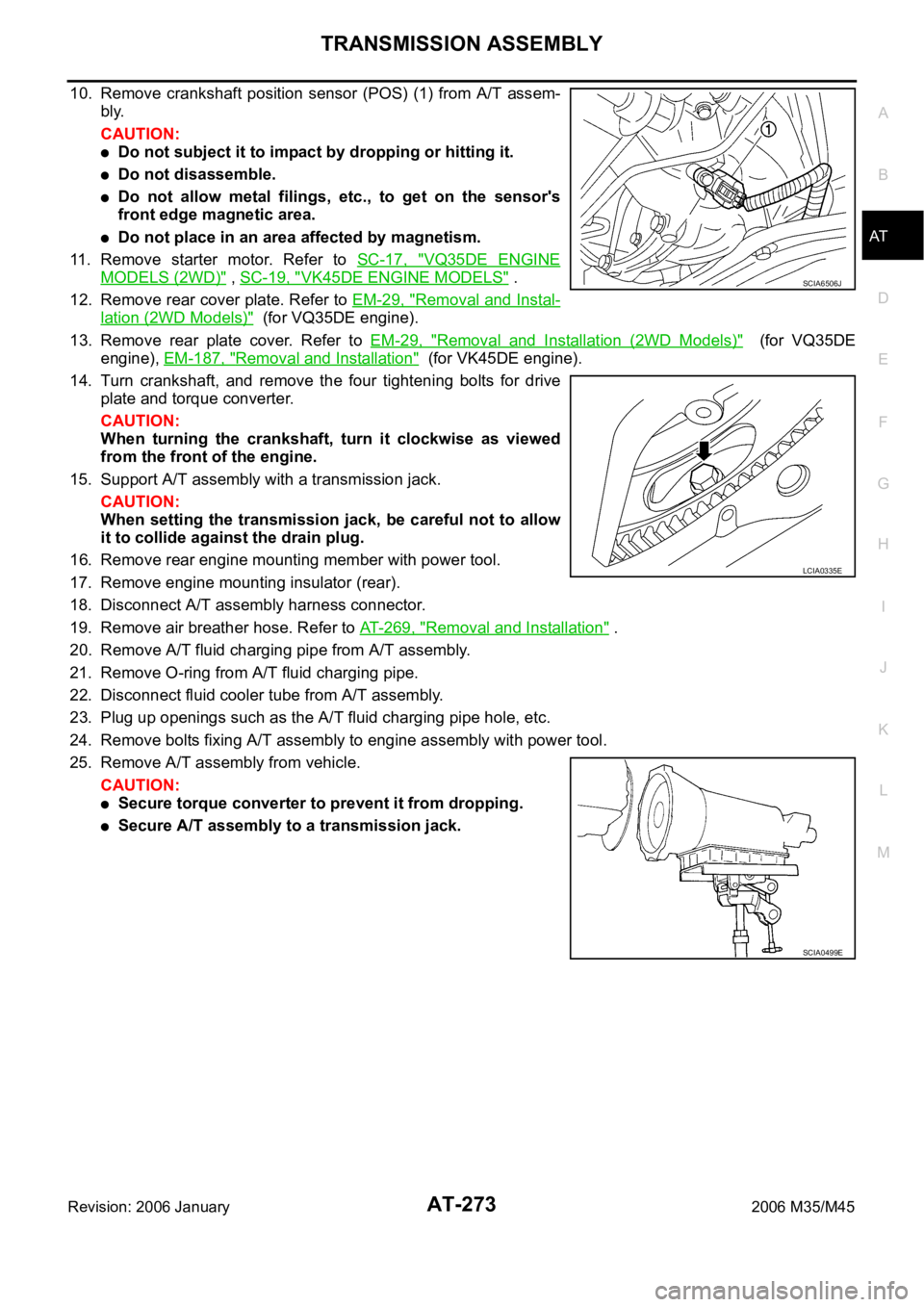
TRANSMISSION ASSEMBLY
AT-273
D
E
F
G
H
I
J
K
L
MA
B
AT
Revision: 2006 January2006 M35/M45
10. Remove crankshaft position sensor (POS) (1) from A/T assem-
bly.
CAUTION:
Do not subject it to impact by dropping or hitting it.
Do not disassemble.
Do not allow metal filings, etc., to get on the sensor's
front edge magnetic area.
Do not place in an area affected by magnetism.
11. Remove starter motor. Refer to SC-17, "
VQ35DE ENGINE
MODELS (2WD)" , SC-19, "VK45DE ENGINE MODELS" .
12. Remove rear cover plate. Refer to EM-29, "
Removal and Instal-
lation (2WD Models)" (for VQ35DE engine).
13. Remove rear plate cover. Refer to EM-29, "
Removal and Installation (2WD Models)" (for VQ35DE
engine), EM-187, "
Removal and Installation" (for VK45DE engine).
14. Turn crankshaft, and remove the four tightening bolts for drive
plate and torque converter.
CAUTION:
When turning the crankshaft, turn it clockwise as viewed
from the front of the engine.
15. Support A/T assembly with a transmission jack.
CAUTION:
When setting the transmission jack, be careful not to allow
it to collide against the drain plug.
16. Remove rear engine mounting member with power tool.
17. Remove engine mounting insulator (rear).
18. Disconnect A/T assembly harness connector.
19. Remove air breather hose. Refer to AT-269, "
Removal and Installation" .
20. Remove A/T fluid charging pipe from A/T assembly.
21. Remove O-ring from A/T fluid charging pipe.
22. Disconnect fluid cooler tube from A/T assembly.
23. Plug up openings such as the A/T fluid charging pipe hole, etc.
24. Remove bolts fixing A/T assembly to engine assembly with power tool.
25. Remove A/T assembly from vehicle.
CAUTION:
Secure torque converter to prevent it from dropping.
Secure A/T assembly to a transmission jack.
SCIA6506J
LCIA0335E
SCIA0499E
Page 355 of 5621
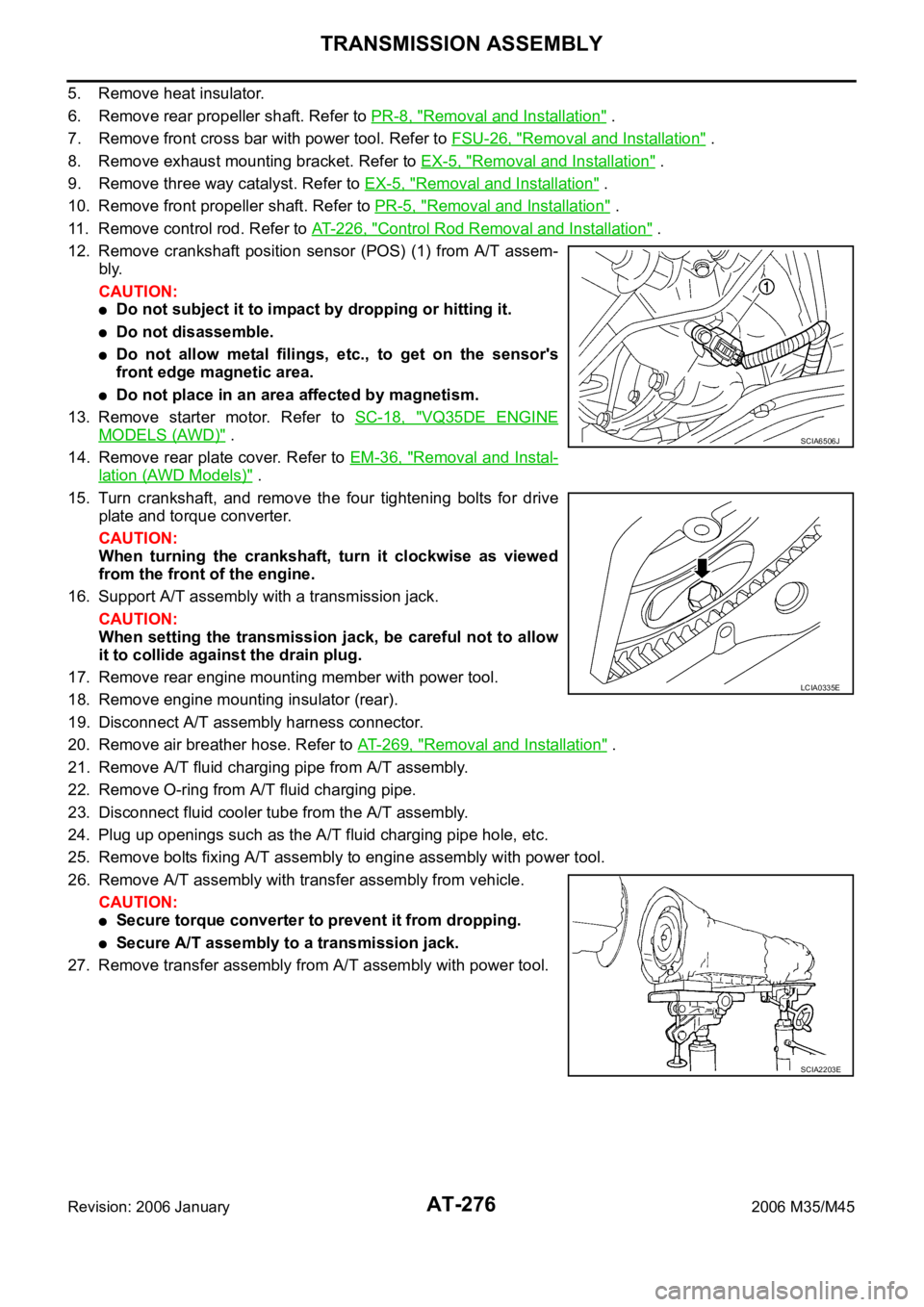
AT-276
TRANSMISSION ASSEMBLY
Revision: 2006 January2006 M35/M45
5. Remove heat insulator.
6. Remove rear propeller shaft. Refer to PR-8, "
Removal and Installation" .
7. Remove front cross bar with power tool. Refer to FSU-26, "
Removal and Installation" .
8. Remove exhaust mounting bracket. Refer to EX-5, "
Removal and Installation" .
9. Remove three way catalyst. Refer to EX-5, "
Removal and Installation" .
10. Remove front propeller shaft. Refer to PR-5, "
Removal and Installation" .
11. Remove control rod. Refer to AT-226, "
Control Rod Removal and Installation" .
12. Remove crankshaft position sensor (POS) (1) from A/T assem-
bly.
CAUTION:
Do not subject it to impact by dropping or hitting it.
Do not disassemble.
Do not allow metal filings, etc., to get on the sensor's
front edge magnetic area.
Do not place in an area affected by magnetism.
13. Remove starter motor. Refer to SC-18, "
VQ35DE ENGINE
MODELS (AWD)" .
14. Remove rear plate cover. Refer to EM-36, "
Removal and Instal-
lation (AWD Models)" .
15. Turn crankshaft, and remove the four tightening bolts for drive
plate and torque converter.
CAUTION:
When turning the crankshaft, turn it clockwise as viewed
from the front of the engine.
16. Support A/T assembly with a transmission jack.
CAUTION:
When setting the transmission jack, be careful not to allow
it to collide against the drain plug.
17. Remove rear engine mounting member with power tool.
18. Remove engine mounting insulator (rear).
19. Disconnect A/T assembly harness connector.
20. Remove air breather hose. Refer to AT- 2 6 9 , "
Removal and Installation" .
21. Remove A/T fluid charging pipe from A/T assembly.
22. Remove O-ring from A/T fluid charging pipe.
23. Disconnect fluid cooler tube from the A/T assembly.
24. Plug up openings such as the A/T fluid charging pipe hole, etc.
25. Remove bolts fixing A/T assembly to engine assembly with power tool.
26. Remove A/T assembly with transfer assembly from vehicle.
CAUTION:
Secure torque converter to prevent it from dropping.
Secure A/T assembly to a transmission jack.
27. Remove transfer assembly from A/T assembly with power tool.
SCIA6506J
LCIA0335E
SCIA2203E
Page 449 of 5621

ATC-2Revision: 2006 January2006 M35/M45 AUTO SWITCH ................................................... 34
DEFROSTER (DEF) SWITCH ............................. 34
UPPER VENT SWITCH ...................................... 34
A/C SWITCH ....................................................... 35
FAN SWITCHES .................................................. 35
OFF SWITCH ...................................................... 35
REAR WINDOW DEFOGGER SWITCH ............. 35
INTAKE SWITCH ................................................. 35
DUAL SWITCH .................................................... 35
Control Operation (Rear Control Switch) ................ 35
AUTO SWITCH ................................................... 35
FAN SWITCH ...................................................... 35
REAR TEMPERATURE CONTROL SWITCH ..... 35
Fail-Safe Function .................................................. 36
Discharge Air Flow ................................................. 37
System Description ................................................. 38
SWITCHES AND THEIR CONTROL FUNCTION ... 38
CAN Communication System Description .............. 39
TROUBLE DIAGNOSIS ............................................ 40
CONSULT-II Function (ECM) .................................. 40
CONSULT-II BASIC OPERATION ....................... 40
DATA MONITOR .................................................. 40
How to Perform Trouble Diagnosis for Quick and
Accurate Repair ...................................................... 40
WORK FLOW ...................................................... 40
SYMPTOM TABLE .............................................. 41
Component Parts and Harness Connector Location ... 42
ENGINE COMPARTMENT .................................. 42
PASSENGER COMPARTMENT .......................... 43
Schematic ............................................................... 44
Wiring Diagram —A/C— ......................................... 46
Auto Amp. Terminals and Reference Value ............ 53
PIN CONNECTOR TERMINAL LAYOUT ............ 53
TERMINALS AND REFERENCE VALUE FOR
UNIFIED METER AND A/C AMP. ........................ 53
Self-diagnosis Function .......................................... 55
DESCRIPTION .................................................... 55
FUNCTION CONFIRMATION PROCEDURE ...... 56
AUXILIARY MECHANISM: TEMPERATURE
SETTING TRIMMER ........................................... 62
AUXILIARY MECHANISM: FOOT POSITION
SETTING TRIMMER ........................................... 63
AUXILIARY MECHANISM: INLET PORT MEM-
ORY FUNCTION ................................................. 63
Operational Check .................................................. 64
CHECKING MEMORY FUNCTION ..................... 64
CHECKING BLOWER ......................................... 64
CHECKING DISCHARGE AIR (MODE SWITCH
AND DEF SWITCH) ............................................ 64
CHECKING DISCHARGE AIR (UPPER VENT
SWITCH) ............................................................. 65
CHECKING INTAKE AIR ..................................... 65
CHECKING TEMPERATURE DECREASE ......... 65
CHECKING TEMPERATURE INCREASE .......... 65
CHECKING A/C SWITCH ................................... 65
CHECKING AUTO MODE ................................... 65
Power Supply and Ground Circuit for Auto Amp. ... 66
INSPECTION FLOW ........................................... 66
COMPONENT DESCRIPTION ............................ 67DIAGNOSIS PROCEDURE FOR A/C SYSTEM ... 67
Rear Control Switch Circuit ..................................... 69
DIAGNOSIS PROCEDURE FOR REAR CON-
TROL SWITCH .................................................... 69
LAN System Circuit ................................................. 70
DIAGNOSIS PROCEDURE FOR LAN CIRCUIT ... 70
Mode Door Motor Circuit ......................................... 75
INSPECTION FLOW ............................................ 76
SYSTEM DESCRIPTION ..................................... 78
COMPONENT DESCRIPTION ............................ 79
DIAGNOSIS PROCEDURE FOR MODE DOOR
MOTOR ................................................................ 79
Upper Ventilator Door Motor Circuit ........................ 80
INSPECTION FLOW ............................................ 80
SYSTEM DESCRIPTION ..................................... 81
COMPONENT DESCRIPTION ............................ 82
DIAGNOSIS PROCEDURE FOR UPPER VEN-
TILATOR DOOR MOTOR .................................... 82
Air Mix Door Motor Circuit ....................................... 83
INSPECTION FLOW ............................................ 83
SYSTEM DESCRIPTION ..................................... 84
COMPONENT DESCRIPTION ............................ 85
DIAGNOSIS PROCEDURE FOR AIR MIX DOOR
MOTOR ................................................................ 85
Air Mix Door Motor PBR Circuit .............................. 85
DIAGNOSIS PROCEDURE FOR AIR MIX DOOR
MOTOR PBR ....................................................... 85
Intake Door Motor Circuit ........................................ 86
INSPECTION FLOW ............................................ 86
SYSTEM DESCRIPTION ..................................... 87
COMPONENT DESCRIPTION ............................ 88
DIAGNOSIS PROCEDURE FOR INTAKE DOOR
MOTOR ................................................................ 88
Blower Motor Circuit ................................................ 89
INSPECTION FLOW ............................................ 89
SYSTEM DESCRIPTION ..................................... 90
COMPONENT DESCRIPTION ............................ 91
DIAGNOSIS PROCEDURE FOR BLOWER
MOTOR ................................................................ 91
COMPONENT INSPECTION ............................... 93
Magnet Clutch Circuit .............................................. 94
INSPECTION FLOW ............................................ 94
SYSTEM DESCRIPTION ..................................... 95
DIAGNOSIS PROCEDURE FOR MAGNET
CLUTCH .............................................................. 95
COMPONENT INSPECTION ............................... 98
Insufficient Cooling .................................................. 99
INSPECTION FLOW ............................................ 99
PERFORMANCE TEST DIAGNOSIS ................101
PERFORMANCE CHART ..................................103
TROUBLE DIAGNOSIS FOR UNUSUAL PRES-
SURE .................................................................105
DIAGNOSIS PROCEDURE FOR INSUFFI-
CIENT COOLING ...............................................107
Insufficient Heating ...............................................109
INSPECTION FLOW ..........................................109
Noise .....................................................................110
INSPECTION FLOW ..........................................110
Self-Diagnosis ....................................................... 111
Page 450 of 5621

ATC-3
C
D
E
F
G
H
I
K
L
MA
B
AT C
Revision: 2006 January2006 M35/M45 INSPECTION FLOW ......................................... . 111
Memory Function .................................................. 112
INSPECTION FLOW .......................................... 112
Ambient Sensor Circuit ......................................... 113
COMPONENT DESCRIPTION .......................... 113
AMBIENT TEMPERATURE INPUT PROCESS .. 113
DIAGNOSIS PROCEDURE FOR AMBIENT
SENSOR ............................................................ 113
COMPONENT INSPECTION ............................. 115
In-Vehicle Sensor Circuit ....................................... 116
COMPONENT DESCRIPTION .......................... 116
DIAGNOSIS PROCEDURE FOR IN-VEHICLE
SENSOR ............................................................ 117
COMPONENT INSPECTION ............................. 118
Sunload Sensor Circuit ......................................... 119
COMPONENT DESCRIPTION .......................... 119
SUNLOAD INPUT PROCESS ........................... 119
DIAGNOSIS PROCEDURE FOR SUNLOAD
SENSOR ............................................................ 119
COMPONENT INSPECTION ............................121
Intake Sensor Circuit ............................................122
COMPONENT DESCRIPTION .........................122
DIAGNOSIS PROCEDURE FOR INTAKE SEN-
SOR ..................................................................122
COMPONENT INSPECTION ............................123
CONTROLLER .......................................................124
Removal and Installation of Multifunction Switch . 124
REMOVAL ........................................................
.124
INSTALLATION .................................................124
AUTO AMP .............................................................125
Removal and Installation of Unified Meter and A/C
Auto Amp. ............................................................125
REMOVAL ........................................................
.125
INSTALLATION .................................................125
AMBIENT SENSOR ................................................126
Removal and Installation ......................................126
REMOVAL ........................................................
.126
INSTALLATION .................................................126
IN-VEHICLE SENSOR ............................................127
Removal and Installation ......................................127
REMOVAL ........................................................
.127
INSTALLATION .................................................127
SUNLOAD SENSOR ..............................................128
Removal and Installation ......................................128
REMOVAL ........................................................
.128
INSTALLATION .................................................128
INTAKE SENSOR .................................................. .129
Removal and Installation ......................................129
REMOVAL ........................................................
.129
INSTALLATION .................................................129
BLOWER UNIT .......................................................130
Removal and Installation ......................................130
REMOVAL ........................................................
.130
INSTALLATION .................................................130
Disassembly and Assembly .................................131
BLOWER MOTOR ..................................................132
Removal and Installation ......................................132
REMOVAL ........................................................
.132
INSTALLATION .................................................132INTAKE DOOR MOTOR .........................................133
Removal and Installation ......................................133
REMOVAL ........................................................
.133
INSTALLATION .................................................133
IN-CABIN MICROFILTER .......................................134
Removal and Installation ......................................134
FUNCTION .......................................................
.134
REPLACEMENT TIMING ..................................134
REPLACEMENT PROCEDURES .....................134
HEATER & COOLING UNIT ASSEMBLY ...............135
Removal and Installation ......................................135
REMOVAL ........................................................
.135
INSTALLATION .................................................136
Disassembly and Assembly ..................................138
MODE DOOR MOTOR ............................................140
Removal and Installation ......................................140
REMOVAL ........................................................
.140
INSTALLATION .................................................140
AIR MIX DOOR MOTOR .........................................141
Removal and Installation ......................................141
REMOVAL ........................................................
.141
INSTALLATION .................................................141
UPPER VENTILATOR DOOR MOTOR ..................142
Removal and Installation ......................................142
REMOVAL ........................................................
.142
INSTALLATION .................................................142
HEATER CORE .......................................................143
Removal and Installation ......................................143
REMOVAL ........................................................
.143
INSTALLATION .................................................143
DUCTS AND GRILLES ...........................................144
Removal and Installation ......................................144
COMPONENT LAYOUT ....................................144
REMOVAL ........................................................
.146
INSTALLATION .................................................150
REFRIGERANT LINES ...........................................151
HFC-134a (R-134a) Service Procedure ...............151
SETTING OF SERVICE TOOLS AND EQUIP-
MENT ................................................................151
Components ....................................................
.....153
VQ35DE ............................................................153
VK45DE .............................................................154
Removal and Installation of Compressor ..............155
REMOVAL ........................................................
.155
INSTALLATION .................................................157
Check Disc to Pulley Clearance ...........................157
Removal and Installation of Low-Pressure Flexible
Hose and Pipe ......................................................158
REMOVAL ........................................................
.158
INSTALLATION .................................................158
Removal and Installation of High-Pressure Flexible
Hose .....................................................................159
REMOVAL ........................................................
.159
INSTALLATION .................................................160
Removal and Installation of High-Pressure Pipe 1
(Engine Compartment) .........................................160
REMOVAL ........................................................
.160
INSTALLATION .................................................161
Removal and Installation of Low-Pressure Pipe 1
Page 476 of 5621
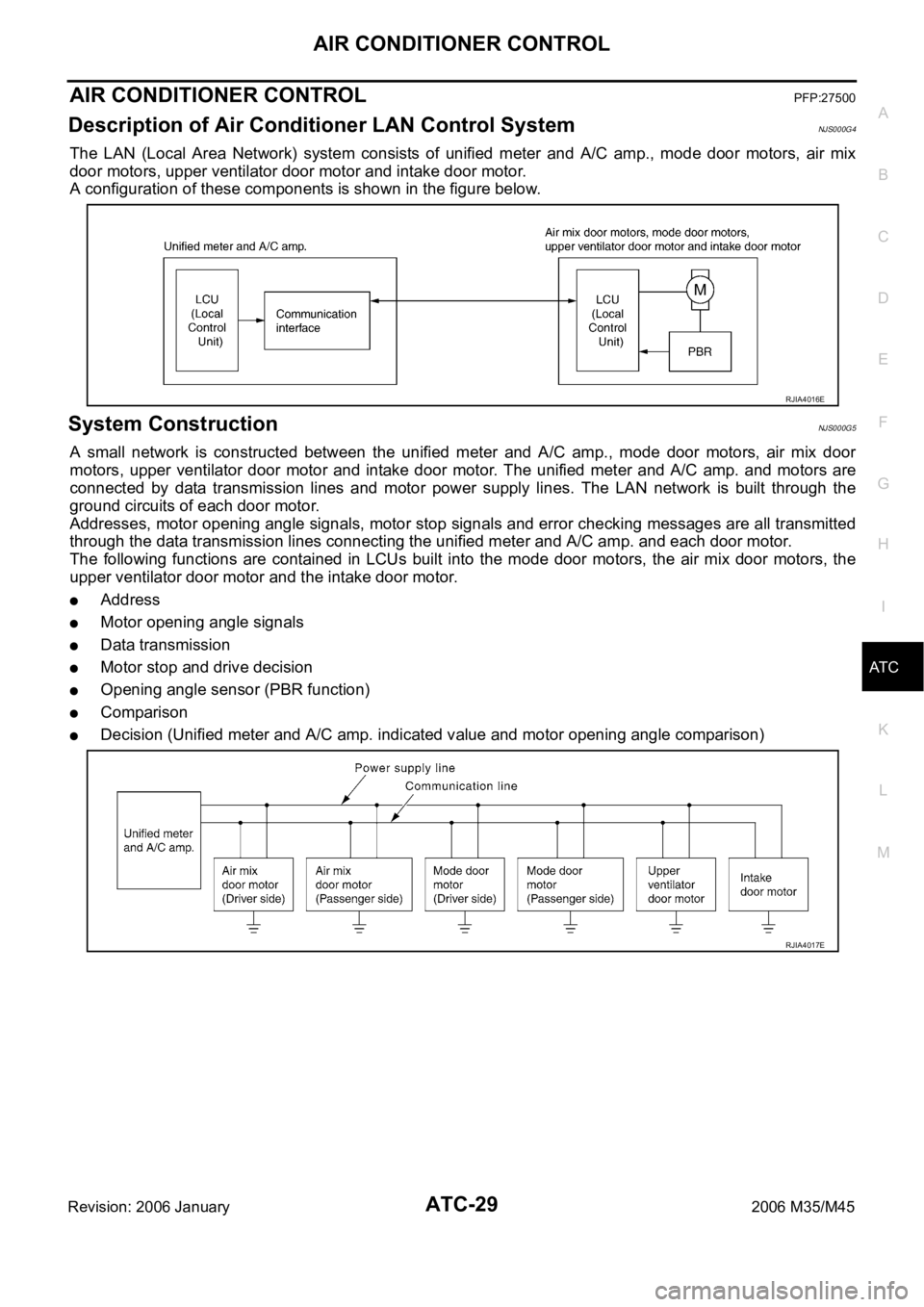
AIR CONDITIONER CONTROL
ATC-29
C
D
E
F
G
H
I
K
L
MA
B
AT C
Revision: 2006 January2006 M35/M45
AIR CONDITIONER CONTROLPFP:27500
Description of Air Conditioner LAN Control SystemNJS000G4
The LAN (Local Area Network) system consists of unified meter and A/C amp., mode door motors, air mix
door motors, upper ventilator door motor and intake door motor.
A configuration of these components is shown in the figure below.
System ConstructionNJS000G5
A small network is constructed between the unified meter and A/C amp., mode door motors, air mix door
motors, upper ventilator door motor and intake door motor. The unified meter and A/C amp. and motors are
connected by data transmission lines and motor power supply lines. The LAN network is built through the
ground circuits of each door motor.
Addresses, motor opening angle signals, motor stop signals and error checking messages are all transmitted
through the data transmission lines connecting the unified meter and A/C amp. and each door motor.
The following functions are contained in LCUs built into the mode door motors, the air mix door motors, the
upper ventilator door motor and the intake door motor.
Address
Motor opening angle signals
Data transmission
Motor stop and drive decision
Opening angle sensor (PBR function)
Comparison
Decision (Unified meter and A/C amp. indicated value and motor opening angle comparison)
RJIA4016E
RJIA4017E
Page 477 of 5621
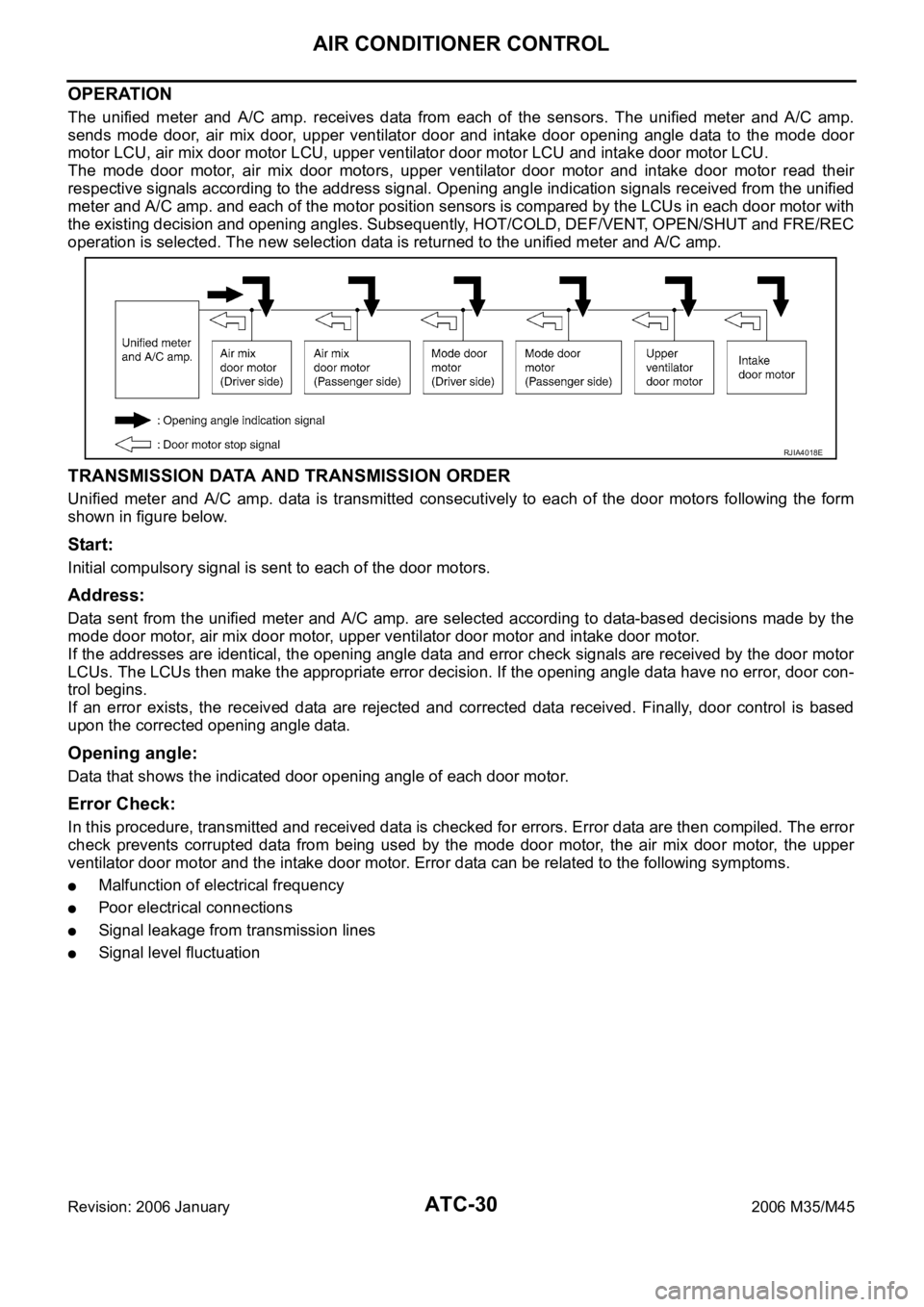
ATC-30
AIR CONDITIONER CONTROL
Revision: 2006 January2006 M35/M45
OPERATION
The unified meter and A/C amp. receives data from each of the sensors. The unified meter and A/C amp.
sends mode door, air mix door, upper ventilator door and intake door opening angle data to the mode door
motor LCU, air mix door motor LCU, upper ventilator door motor LCU and intake door motor LCU.
The mode door motor, air mix door motors, upper ventilator door motor and intake door motor read their
respective signals according to the address signal. Opening angle indication signals received from the unified
meter and A/C amp. and each of the motor position sensors is compared by the LCUs in each door motor with
the existing decision and opening angles. Subsequently, HOT/COLD, DEF/VENT, OPEN/SHUT and FRE/REC
operation is selected. The new selection data is returned to the unified meter and A/C amp.
TRANSMISSION DATA AND TRANSMISSION ORDER
Unified meter and A/C amp. data is transmitted consecutively to each of the door motors following the form
shown in figure below.
Start:
Initial compulsory signal is sent to each of the door motors.
Address:
Data sent from the unified meter and A/C amp. are selected according to data-based decisions made by the
mode door motor, air mix door motor, upper ventilator door motor and intake door motor.
If the addresses are identical, the opening angle data and error check signals are received by the door motor
LCUs. The LCUs then make the appropriate error decision. If the opening angle data have no error, door con-
trol begins.
If an error exists, the received data are rejected and corrected data received. Finally, door control is based
upon the corrected opening angle data.
Opening angle:
Data that shows the indicated door opening angle of each door motor.
Error Check:
In this procedure, transmitted and received data is checked for errors. Error data are then compiled. The error
check prevents corrupted data from being used by the mode door motor, the air mix door motor, the upper
ventilator door motor and the intake door motor. Error data can be related to the following symptoms.
Malfunction of electrical frequency
Poor electrical connections
Signal leakage from transmission lines
Signal level fluctuation
RJIA4018E
Page 478 of 5621
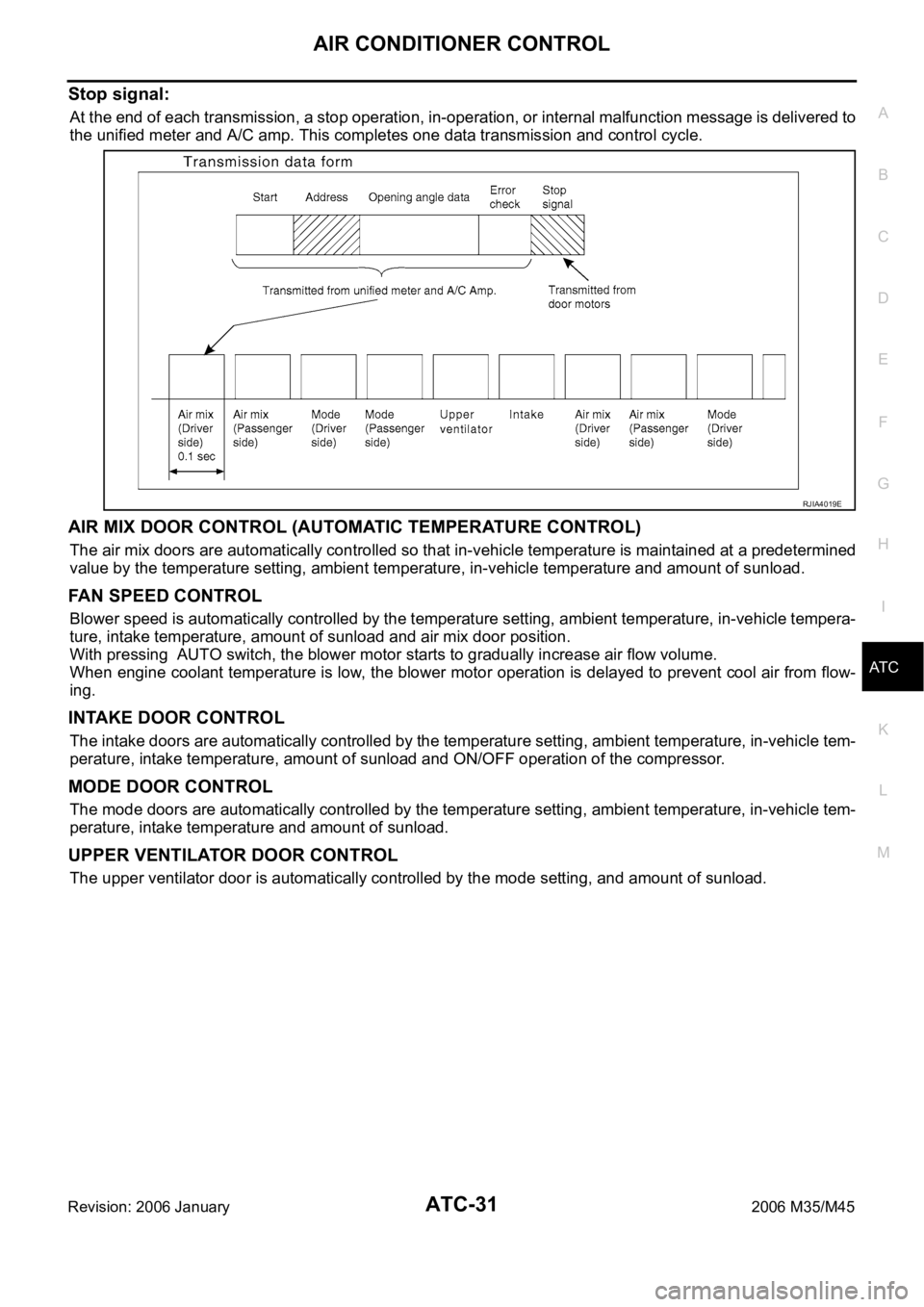
AIR CONDITIONER CONTROL
ATC-31
C
D
E
F
G
H
I
K
L
MA
B
AT C
Revision: 2006 January2006 M35/M45
Stop signal:
At the end of each transmission, a stop operation, in-operation, or internal malfunction message is delivered to
the unified meter and A/C amp. This completes one data transmission and control cycle.
AIR MIX DOOR CONTROL (AUTOMATIC TEMPERATURE CONTROL)
The air mix doors are automatically controlled so that in-vehicle temperature is maintained at a predetermined
value by the temperature setting, ambient temperature, in-vehicle temperature and amount of sunload.
FAN SPEED CONTROL
Blower speed is automatically controlled by the temperature setting, ambient temperature, in-vehicle tempera-
ture, intake temperature, amount of sunload and air mix door position.
With pressing AUTO switch, the blower motor starts to gradually increase air flow volume.
When engine coolant temperature is low, the blower motor operation is delayed to prevent cool air from flow-
ing.
INTAKE DOOR CONTROL
The intake doors are automatically controlled by the temperature setting, ambient temperature, in-vehicle tem-
perature, intake temperature, amount of sunload and ON/OFF operation of the compressor.
MODE DOOR CONTROL
The mode doors are automatically controlled by the temperature setting, ambient temperature, in-vehicle tem-
perature, intake temperature and amount of sunload.
UPPER VENTILATOR DOOR CONTROL
The upper ventilator door is automatically controlled by the mode setting, and amount of sunload.
RJIA4019E
Page 487 of 5621

ATC-40
TROUBLE DIAGNOSIS
Revision: 2006 January2006 M35/M45
TROUBLE DIAGNOSISPFP:00004
CONSULT-II Function (ECM)NJS000GD
CONSULT-II can display each diagnosis item using the diagnosis test modes shown following.
CONSULT-II BASIC OPERATION
Refer to GI-39, "CONSULT-II Start Procedure" .
DATA MONITOR
Operation Procedure
1. Touch “ENGINE” on “SELECT SYSTEM” screen.
2. Touch “DATA MONITOR” on “SELECT DIAG MODE” screen.
3. Touch either “ALL SIGNALS” or “SELECTION FROM MENU” on “DATA MONITOR” screen.
4. When “SELECTION FROM MENU” is selected, touch items to be monitored. When “ALL SIGNALS” is
selected, all the items will be monitored.
5. Touch “START”.
6. Touch “RECORD” while monitoring, then the status of the monitored item can be recorded. To stop
recording, touch “STOP”.
Display Item List
How to Perform Trouble Diagnosis for Quick and Accurate RepairNJS000GE
WORK FLOW
System part Check item, diagnosis mode Description
ECM Data monitor Displays ECM input data in real time.
All signals Monitors all the items.
Selection from menu Selects and monitors the individual item selected.
Monitor item name
“operation or unit”Contents
IGN ON SW “ON/OFF” Displays “IGN position (ON)/OFF, ACC position (OFF)” status as judged from ignition switch signal.
FAN ON SIG “ON/OFF” Displays “FAN (ON)/FAN (OFF)” status as judged from blower fan motor switch signal.
AIR COND SW “ON/OFF” Displays “COMP (ON)/COMP (OFF)” status as judged from air conditioner switch signal.
REFRIGERANT
PRESSURE SEN-
SOR “V”Displays “Refrigerant pressure sensor for voltage” status as inputted from refrigerant pressure sen-
sor.
*1ATC-64, "Operational Check"
SHA900E